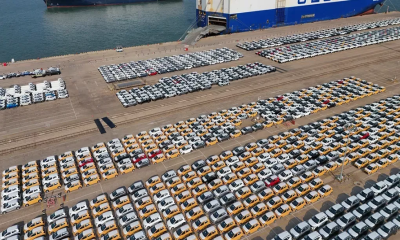China has responded to Donald Trump’s trade move by hitting back with a stronger action.
After Trump imposed a 10% tariff on Chinese goods, China decided to up the ante by slapping a 15% tariff on American products.
In this move, China has gone beyond what Trump did, raising the stakes in this trade battle. This sharp response was reported by DW Bangla.
Adding to the tension, Beijing’s anti-monopoly agency has also launched an investigation into tech giant Google.
On Tuesday, the U.S. began enforcing a 10% tariff on goods imported from China.
Just moments after this came into effect, China’s Ministry of Finance retaliated with the announcement of a 15% tariff on U.S. products.
China’s Ministry of Commerce has also put some controls in place regarding the import of certain items, although the specifics were not immediately clear.
Trump’s Moves on Mexico and Canada
In a separate development, Trump said he would temporarily hold off on imposing a 25% tariff on goods from Canada and Mexico for 30 days.
This decision came after Canada agreed to step up border security, including taking measures to prevent the smuggling of fentanyl and other drugs.
Canadian Prime Minister Justin Trudeau announced that his country has also removed the 25% tariff it had earlier imposed on U.S. goods in response.
“As President, it’s my duty to ensure the safety of all American citizens,” Trump said.
“I am pleased with the talks, and therefore I’m suspending the tariff decision for 30 days.”
Earlier, Trump also mentioned that after a discussion with Mexican President Claudia Sheinbaum, he had agreed to a 30-day postponement on tariffs for Mexican goods.
He added that the Mexican president had agreed to deploy 10,000 troops to the U.S.-Mexico border to aid in security.
EU Must Stand Together Against Trump’s Economic Moves, German Politician Says
Friedrich Merz, the leader of Germany’s CDU party, weighed in on the economic pressure Trump has placed on Europe, saying that the European Union must unite to face this challenge head-on.
Speaking to DW, Merz said,
“We have experienced something like this before.”
After Trump’s first election, he imposed tariffs on some European products. In response, the EU imposed its own tariffs on American goods like jeans, whiskey, and motorcycles. The U.S. eventually backed down and lifted the tariffs.
“We have to come together as one to handle what Trump is doing,” Merz said.
According to recent polls, Merz is favored to become Germany’s next chancellor after the February 23 election.
The U.S.-EU Trade Deficit Explained
The trade imbalance between the U.S. and the EU is another critical issue. A trade deficit happens when one country imports more than it exports to another.
In this case, the U.S. imports a lot more from the European Union than it exports to them.
The EU, which consists of 27 nations, shipped $503 billion worth of goods to the U.S. in 2023. The most exported items were cars and pharmaceuticals.
In return, the U.S. exported $347 billion worth of goods to the EU in 2023, leaving the U.S. with a trade deficit of $156 billion with the EU.
This situation seems to be heating up, with both sides locking horns in a way that could have significant effects on international trade.
If China’s 15% tariff isn’t the final word in this ongoing battle, we may see further actions in the coming days.
Similarly, Europe is now strategizing its next moves against the backdrop of Trump’s tariffs.

















-20251213120612.webp)

















-20251207131533.jpg)



